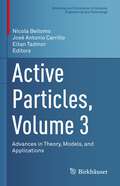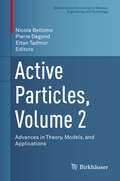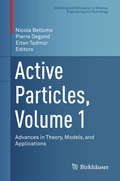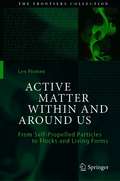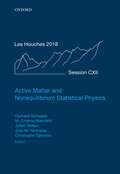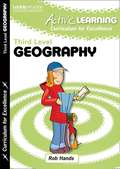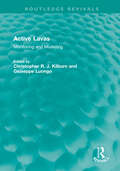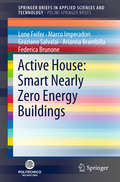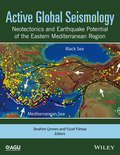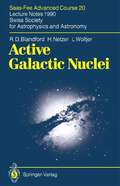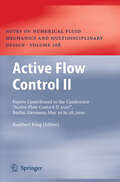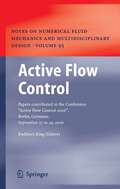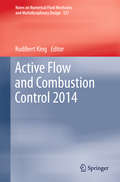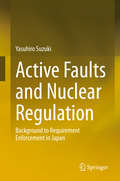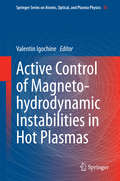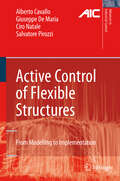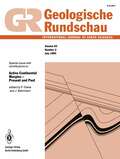- Table View
- List View
Active tectonics of the Hellenic subduction zone (Springer Theses)
by Beth ShawThis thesis is remarkable for the wide range of the techniques and observations used and for its insights, which cross several disciplines. It begins by solving a famous puzzle of the ancient world, which is what was responsible for the tsunami that destroyed settlements in the eastern Mediterranean in 365 AD. By radiocarbon dating of preserved marine organisms, Shaw demonstrates that the whole of western Crete was lifted out of the sea by up to 10 meters in a massive earthquake at that time, which occured on a previously unknown fault. The author shows that the resulting tsunami would have the characteristics described by ancient writers, and uses modern GPS measurements and coastline geomorphology to show that the strain build-up near Crete requires such a tsunami-earthquake about every 6.000 years - a major insight into Mediterranean tsunami hazard. A detailed seismological study of earthquakes in the Cretan arc over the last 50 years reveals other important features of its behaviour that were previously unknown. Finally, she provides fundamental insights into the limitations of radiocarbon dating marine organisms, relating to how they secrete carbon into their skeletons. The thesis resulted in three major papers in top journals.
Active Tectonics of Kumaun and Garhwal Himalaya (Springer Natural Hazards)
by R. Jayangondaperumal V. C. Thakur V. Joevivek Priyanka Singh Rao Anil Kumar GuptaThe book contributes to understanding the pattern of strain release and the level of seismic hazard imposed by large-great earthquakes in the frontal fold-thrust belts of Kumaun and Garhwal regions of Uttarakhand. The motivation for active fault studies and their characterization have been emphasized. The book presents the compilation of knowledge garnered in multidisciplinary or proxy studies involved in the understanding of seismic hazard in general and Kumaun–Garhwal Himalaya regions in particular with lucid new maps draped on modern Cartosat or SRTM DEM data. It also discusses satellite image calibration, active faults identifications, and map productions with flowchart. The book discusses window-wise active fault elements with attributes together with the tectonic geomorphic map. It also includes active fault scarp with topographic profile along with field photographs. Finally, it reviews all existing seismotectonic models of the Himalaya, its earthquake hazard, and its vulnerability, specifically for Kumaun and Garhwal regions.
Active Tectonics and Seismic Potential of Alaska (Geophysical Monograph Series #179)
by Jeffrey T. Freymueller Peter J. Haeussler Robert L. Wesson Göran EkströmPublished by the American Geophysical Union as part of the Geophysical Monograph Series, Volume 179. This multidisciplinary monograph provides the first modern integrative summary focused on the most spectacular active tectonic systems in North America. Encompassing seismology, tectonics, geology, and geodesy, it includes papers that summarize the state of knowledge, including background material for those unfamiliar with the region; address global hypotheses using data from Alaska; and test important global hypotheses using data from this region. It is organized around four major themes: subduction and great earthquakes at the Aleutian Arc, the transition from strike slip to accretion and subduction of the Yakutat microplate, the Denali fault and related structures and their role in accommodating permanent deformation of the overriding plate, and regional integration and large-scale models and the use of data from Alaska to address important global questions and hypotheses. The book's publication near the beginning of the National Science Foundation's EarthScope project makes it especially timely because Alaska is perhaps the least understood area within the EarthScope footprint, and interest in the region can be expected to rise with time as more EarthScope data become available.
Active Tectonics and Seismic Potential of Alaska (Geophysical Monograph Series #179)
by Jeffrey T. Freymueller Peter J. Haeussler Robert L. Wesson Göran EkströmPublished by the American Geophysical Union as part of the Geophysical Monograph Series, Volume 179. This multidisciplinary monograph provides the first modern integrative summary focused on the most spectacular active tectonic systems in North America. Encompassing seismology, tectonics, geology, and geodesy, it includes papers that summarize the state of knowledge, including background material for those unfamiliar with the region; address global hypotheses using data from Alaska; and test important global hypotheses using data from this region. It is organized around four major themes: subduction and great earthquakes at the Aleutian Arc, the transition from strike slip to accretion and subduction of the Yakutat microplate, the Denali fault and related structures and their role in accommodating permanent deformation of the overriding plate, and regional integration and large-scale models and the use of data from Alaska to address important global questions and hypotheses. The book's publication near the beginning of the National Science Foundation's EarthScope project makes it especially timely because Alaska is perhaps the least understood area within the EarthScope footprint, and interest in the region can be expected to rise with time as more EarthScope data become available.
Active Seismic Tomography: Theory and Applications
by Kalachand Sain Damodara NaraImaging complex regions or difficult terrains like the sub-volcanic sediments or thrust fold belt areas is crucial to understanding the earth's subsurface. Active Seismic Tomography: Theory and Applications describes current technologies for the study of seismic velocities and the elucidation of fine details of the subsurface. Key use cases include hydrocarbon reservoir characterization, identification of faults and channels, and stratigraphic and structural traps.Volume highlights include: Theory and development of seismic tomographyNumerous examples of the interpretation and analysis of active source seismic data Relevance of tomography data for computational geophysicists This volume is a valuable resource for academics and professionals interested in using or developing integrated imaging approaches of the Earth's subsurface.
Active Seismic Tomography: Theory and Applications
by Kalachand Sain Damodara NaraImaging complex regions or difficult terrains like the sub-volcanic sediments or thrust fold belt areas is crucial to understanding the earth's subsurface. Active Seismic Tomography: Theory and Applications describes current technologies for the study of seismic velocities and the elucidation of fine details of the subsurface. Key use cases include hydrocarbon reservoir characterization, identification of faults and channels, and stratigraphic and structural traps.Volume highlights include: Theory and development of seismic tomographyNumerous examples of the interpretation and analysis of active source seismic data Relevance of tomography data for computational geophysicists This volume is a valuable resource for academics and professionals interested in using or developing integrated imaging approaches of the Earth's subsurface.
Active Particles, Volume 3: Advances in Theory, Models, and Applications (Modeling and Simulation in Science, Engineering and Technology)
by Nicola Bellomo José Antonio Carrillo Eitan TadmorThis edited volume collects six surveys that present state-of-the-art results on modeling, qualitative analysis, and simulation of active matter, focusing on specific applications in the natural sciences. Following the previously published Active Particles volumes, these chapters are written by leading experts in the field and reflect the diversity of subject matter in theory and applications within an interdisciplinary framework. Topics covered include:Variability and heterogeneity in natural swarmsMultiscale aspects of the dynamics of human crowdsMathematical modeling of cell collective motion triggered by self-generated gradientsClustering dynamics on graphsRandom Batch Methods for classical and quantum interacting particle systemsThe consensus-based global optimization algorithm and its recent variantsMathematicians and other members of the scientific community interested in active matter and its many applications will find this volume to be a timely, authoritative, and valuable resource.
Active Particles, Volume 2: Advances in Theory, Models, and Applications (Modeling and Simulation in Science, Engineering and Technology)
by Nicola Bellomo Pierre Degond Eitan TadmorThis volume compiles eight recent surveys that present state-of-the-art results in the field of active matter at different scales, modeled by agent-based, kinetic, and hydrodynamic descriptions. Following the previously published volume, these chapters were written by leading experts in the field and accurately reflect the diversity of subject matter in theory and applications. Several mathematical tools are employed throughout the volume, including analysis of nonlinear PDEs, network theory, mean field approximations, control theory, and flocking analysis. The book also covers a wide range of applications, including:Biological network formationSocial systemsControl theory of sparse systemsDynamics of swarming and flocking systemsStochastic particles and mean field approximationsMathematicians and other members of the scientific community interested in active matter and its many applications will find this volume to be a timely, authoritative, and valuable resource.
Active Particles, Volume 1: Advances in Theory, Models, and Applications (Modeling and Simulation in Science, Engineering and Technology)
by Nicola Bellomo Pierre Degond Eitan TadmorThis volume collects ten surveys on the modeling, simulation, and applications of active particles using methods ranging from mathematical kinetic theory to nonequilibrium statistical mechanics. The contributing authors are leading experts working in this challenging field, and each of their chapters provides a review of the most recent results in their areas and looks ahead to future research directions. The approaches to studying active matter are presented here from many different perspectives, such as individual-based models, evolutionary games, Brownian motion, and continuum theories, as well as various combinations of these. Applications covered include biological network formation and network theory; opinion formation and social systems; control theory of sparse systems; theory and applications of mean field games; population learning; dynamics of flocking systems; vehicular traffic flow; and stochastic particles and mean field approximation. Mathematicians and other members of the scientific community interested in active matter and its many applications will find this volume to be a timely, authoritative, and valuable resource.
Active Matter Within and Around Us: From Self-Propelled Particles to Flocks and Living Forms (The Frontiers Collection)
by Len PismenThis book presents a comprehensive review of various aspects of the novel and rapidly developing field of active matter, which encompasses a wide variety of self-organized self-driven energy-consuming media or agents. Most naturally occurring examples are of biological origin, spanning all scales from intracellular structures to swimming and crawling cells and microorganisms, to living tissues, bacterial colonies and flocks of birds. But the field also encompasses artificial systems, from colloids to soft robots. Intrinsically out of equilibrium and free of constraints of time-reversal symmetry, such systems display a range of surprising and unusual behaviors. In this book, the author emphasizes connections between fluid-mechanical, material, biological and technological aspects of active matter. He employs a minimum of mathematical tools, ensuring that the presentation is accessible to a wider scientific community. Richly illustrated, it gives the reader a clear picture of this fascinating field, its diverse phenomena and its open questions.
Active Matter and Nonequilibrium Statistical Physics: Lecture Notes of the Les Houches Summer School: Volume 112, September 2018 (Lecture Notes of the Les Houches Summer School #112)
From molecular motors to bacteria, from crawling cells to large animals, active entities are found at all scales in the biological world. Active matter encompasses systems whose individual constituents irreversibly dissipate energy to exert self-propelling forces on their environment. Over the past twenty years, scientists have managed to engineer synthetic active particles in the lab, paving the way towards smart active materials. This book gathers a pedagogical set of lecture notes that cover topics in nonequilibrium statistical mechanics and active matter. These lecture notes stem from the first summer school on Active Matter delivered at the Les Houches school of Physics. The lectures covered four main research directions: collective behaviours in active-matter systems, passive and active colloidal systems, biophysics and active matter, and nonequilibrium statistical physics—from passive to active.
Active Learning — Active Geography: Third Level (PDF)
by Rob Hands Leckie Leckie StaffFocusing specifically on building skills – both geographical and higher order thinking skills – Active Geography covers the Third Level Outcomes and Experiences for geography in an engaging, activity-based way. Containing project ideas, co-operative learning tasks, literacy-based activities and games, it offers a toolkit of ideas to help you effectively implement Curriculum for Excellence with your class.
Active Lavas: Monitoring and Modelling (Routledge Revivals)
by Christopher R.J. Kilburn Giuseppe LuongoOriginally published in 1993, Active Lavas looks at the practical aspects of monitoring uncontrolled streams of molten rock and how field data can be applied for theoretical modelling and forecasting the growth of lava flows. It describes the basic features of common subaerial lava flows and domes – both on Earth and on other bodies in the Solar System – before discussing the logistics of measuring lava properties during eruption and how these measurements are used to develop simple theoretical models for forecasting flow behaviour.
Active Lavas: Monitoring and Modelling (Routledge Revivals)
by Christopher R. J. Kilburn Giuseppe LuongoOriginally published in 1993, Active Lavas looks at the practical aspects of monitoring uncontrolled streams of molten rock and how field data can be applied for theoretical modelling and forecasting the growth of lava flows. It describes the basic features of common subaerial lava flows and domes – both on Earth and on other bodies in the Solar System – before discussing the logistics of measuring lava properties during eruption and how these measurements are used to develop simple theoretical models for forecasting flow behaviour.
Active House: Smart Nearly Zero Energy Buildings (SpringerBriefs in Applied Sciences and Technology)
by Lone Feifer Marco Imperadori Graziano Salvalai Arianna Brambilla Federica BrunoneThe book provides an overview of the Active House (AH) vision, intended as a building design method “beyond” the passive approach for buildings of the future that will be more and more connected, smart and innovative. It offers a novel philosophical design approach in which buildings, new or renovated, are in balance with natural, renewable energies and become “concentrators-distributors” of energies instead of being consumers of resources. The book is composed of five chapters, providing information on fundamental aspects of innovations toward resource-efficient buildings, as well as case studies presenting the concept in practice. It demonstrates that a completely new design approach is possible, and that a turning point has been reached. Lastly, it shows how the AH Alliance, along with designers, institutions, industries and academies, is bringing a breath of fresh air to the world of construction.
Active Global Seismology: Neotectonics and Earthquake Potential of the Eastern Mediterranean Region (Geophysical Monograph Series #225)
by Ibrahim Cemen Yucel YilmazNeotectonics involves the study of the motions and deformations of the Earth's crust that are current or recent in geologic time. The Mediterranean region is one of the most important regions for neotectonics and related natural hazards. This volume focuses on the neotectonics of the Eastern Mediterranean region, which has experienced many major extensive earthquakes, including the devastating Izmit, Turkey earthquake on August 17, 1999. The event lasted for 37 seconds, killing around 17,000 people, injuring 44,000 people, and leaving approximately half a million people homeless. Since then, several North American, European, and Turkish research groups have studied the neotectonics and earthquake potential of the region using different geological and geophysical methods, including GPS studies, geodesy, and passive source seismology. Some results from their studies were presented in major North American and European geological meetings. This volume highlights the work involving the Eastern Mediterranean region, which has one of the world's longest and best studied active strike-slip (horizontal motion) faults: the east-west trending North Anatolian fault zone, which is very similar to the San Andreas fault in California. This volume features discussions of: Widespread applications in measuring plate motion that have strong implications in predicting natural disasters like earthquakes, both on a regional and a global scale Recent motions, particularly those produced by earthquakes, that provide insights on the physics of earthquake recurrence, the growth of mountains, orogenic movements, and seismic hazards Unique methodical approaches in collecting tectonophysical data, including field, seismic, experimental, computer-based, and theoretical approaches. Active Global Seismology is a valuable resource for geoscientists, particularly in the field of tectonophysics, geophysics, geodynamics, seismology, structural geology, environmental geology, and geoengineering. Read an interview with the editors to find out more:https://eos.org/editors-vox/neotectonics-and-earthquake-forecasting
Active Global Seismology: Neotectonics and Earthquake Potential of the Eastern Mediterranean Region (Geophysical Monograph Series #225)
by Ibrahim Emen Yucel YilmazNeotectonics involves the study of the motions and deformations of the Earth's crust that are current or recent in geologic time. The Mediterranean region is one of the most important regions for neotectonics and related natural hazards. This volume focuses on the neotectonics of the Eastern Mediterranean region, which has experienced many major extensive earthquakes, including the devastating Izmit, Turkey earthquake on August 17, 1999. The event lasted for 37 seconds, killing around 17,000 people, injuring 44,000 people, and leaving approximately half a million people homeless. Since then, several North American, European, and Turkish research groups have studied the neotectonics and earthquake potential of the region using different geological and geophysical methods, including GPS studies, geodesy, and passive source seismology. Some results from their studies were presented in major North American and European geological meetings. This volume highlights the work involving the Eastern Mediterranean region, which has one of the world's longest and best studied active strike-slip (horizontal motion) faults: the east-west trending North Anatolian fault zone, which is very similar to the San Andreas fault in California. This volume features discussions of: Widespread applications in measuring plate motion that have strong implications in predicting natural disasters like earthquakes, both on a regional and a global scale Recent motions, particularly those produced by earthquakes, that provide insights on the physics of earthquake recurrence, the growth of mountains, orogenic movements, and seismic hazards Unique methodical approaches in collecting tectonophysical data, including field, seismic, experimental, computer-based, and theoretical approaches. Active Global Seismology is a valuable resource for geoscientists, particularly in the field of tectonophysics, geophysics, geodynamics, seismology, structural geology, environmental geology, and geoengineering. Read an interview with the editors to find out more:https://eos.org/editors-vox/neotectonics-and-earthquake-forecasting
Active Galactic Nuclei: Saas-Fee Advanced Course 20. Lecture Notes 1990. Swiss Society for Astrophysics and Astronomy (Saas-Fee Advanced Course #20)
by R.D. Blandford H. Netzer L. WoltjerThe Swiss Society for Astrophysics and Astronomy organizes each year in the late winter or early spring an advanced course. The format of the school is always iden tical: three leading lecturers are invited to cover the subject in nine or ten lectures each and to deliver a written version of their lecture notes. Lectures are held in the morning and late afternoon, thus leaving ample time for discussion and skiing. These arrangements prove very convivial and lead to an excellent atmosphere in which to learn exciting new subjects and establish contacts with colleagues. A wide variety of people attend the school, including many young students, mostly from Europe, and some experienced researchers. The 20th Advanced Course of the Swiss Society for Astrophysics and Astronomy took place in Les Diablerets from 1 to 6 April 1990. It was devoted to observational and theoretical aspects of active galactic nuclei. The previous advanced courses of the Swiss Society for Astrophysics and Astronomy have regularly taken place in Saas-Fee, a small resort in the Swiss Alps, hence the name "Saas-Fee" used to de scribe the courses and lecture notes. In the last three years, however, the course was organized in Leysin and in Les Diablerets, both also situated in the Swiss Alps.
Active Flow Control II: Papers Contributed to the Conference “Active Flow Control II 2010”, Berlin, Germany, May 26 to 28, 2010 (Notes on Numerical Fluid Mechanics and Multidisciplinary Design #108)
by Rudibert KingThe interest in the field of active flow control (AFC) is steadily increasing. In - cent years the number of conferences and special sessions devoted to AFC org- ized by various institutions around the world continuously rises. New advanced courses for AFC are offered by the American Institute of Aeronautics and Ast- nautics (AIAA), the European Research Community on Flow, Turbulence and Combustion (ERCOFTAC), the International Centre for Mechanical Sciences (CISM), the von Karman Institute for Fluid Dynamics (VKI), to name just a few. New books on AFC are published by prominent colleagues of our field and even a new periodical, the ‘International Journal of Flow Control’, appeared. Despite these many activities in AFC it was felt that a follow-up of the highly successful ‘ACTIVE FLOW CONTROL’ Conference held in Berlin in 2006 was appropriate. As in 2006, ‘ACTIVE FLOW CONTROL II’ consisted only of invited lectures. To sti- late multidisciplinary discussions between experimental, theoretical and numerical fluid dynamics, aerodynamics, turbomachinary, mathematics, control engineering, metrology and computer science parallel sessions were excluded. Unfortunately, not all of the presented papers made it into this volume. As the preparation and printing of a book takes time and as this volume should be available at the conf- ence, the Local Organizing Committee had to set up a very ambitious time sch- ule which could not be met by all contributors.
Active Flow Control: Papers contributed to the Conference “Active Flow Control 2006”, Berlin, Germany, September 27 to 29, 2006 (Notes on Numerical Fluid Mechanics and Multidisciplinary Design #95)
by Rudibert KingThis book contains contributions presented at the Active Flow Control 2006 conference, held September 2006, at the Technische Universität Berlin, Germany. It contains a well balanced combination of theoretical and experimental state-of-the-art results of Active Flow Control. Coverage combines new developments in actuator technology, sensing, robust and optimal open- and closed-loop control and model reduction for control.
Active Flow and Combustion Control 2014 (Notes on Numerical Fluid Mechanics and Multidisciplinary Design #127)
by Rudibert KingThe book reports on the latest theoretical and experimental advances in the field of active flow and combustion control. It covers new developments in actuator technology and sensing, in robust and optimal open- and closed-loop control, as well as in model reduction for control. It collects contributions presented during the third edition of the Active Flow and Combustion Control conference, held in September 10-12, 2014 at the Technische Universität Berlin (Germany). This conference, as well as the research presented in the book, have been supported by the collaborative research center SFB 1029 -Substantial efficiency increase in gas turbines through direct use of coupled unsteady combustion and flow dynamics, funded by the DFG (German Research Foundation).
Active Faults and Nuclear Regulation: Background to Requirement Enforcement in Japan
by Yasuhiro SuzukiThis book reviews the active faults around nuclear power plants in Japan and recommends an optimal method of nuclear power regulation controlled by the Nuclear Regulation Authority of Japan. The active faults around nuclear power plants have been underestimated in Japan since the latter half of the 20th century. However, based on the lessons learned from the Fukushima nuclear power plant accident, the book sheds light on why the risks of active faults were underestimated, and discusses the optimal scientific method of assessing those risks. Further, the author shares his experiences in the new standard for nuclear regulation creation team and in the active fault survey at the Nuclear Regulation Authority of Japan. This book is a valuable resource for students, researchers, academic and policy-makers, as well as non-experts interested in nuclear safety.
Active Control of Magneto-hydrodynamic Instabilities in Hot Plasmas (Springer Series on Atomic, Optical, and Plasma Physics #83)
by Valentin IgochineDuring the past century, world-wide energy consumption has risen dramatically, which leads to a quest for new energy sources. Fusion of hydrogen atoms in hot plasmas is an attractive approach to solve the energy problem, with abundant fuel, inherent safety and no long-lived radioactivity. However, one of the limits on plasma performance is due to the various classes of magneto-hydrodynamic instabilities that may occur. The physics and control of these instabilities in modern magnetic confinement fusion devices is the subject of this book. Written by foremost experts, the contributions will provide valuable reference and up-to-date research reviews for "old hands" and newcomers alike.
Active Control of Flexible Structures: From Modeling to Implementation (Advances in Industrial Control)
by Alberto Cavallo Giuseppe de Maria Ciro Natale Salvatore PirozziA complete solution for problems of vibration control in structures that may be subject to a broadband primary vibration field, this book addresses the following steps: experimental identification of the dynamic model of the structure; optimal placement of sensors and actuators; formulation of control constraints in terms of controller frequency response shape; controller design and simulation; and controller implementation and rapid prototyping. The identification procedure is a gray-box approach tailored to the estimation of modal parameters of large-scale flexible structures. The actuator/sensor placement algorithm maximizes a modal controllability index improving the effectiveness of the control. Considering limitations of sensors and actuators, the controller is chosen as a stable, band-pass MIMO system resulting from the closed-form solution of a robust control problem. Experimental results on an aeronautical stiffened skin panel are presented using rapid-prototyping hardware.




